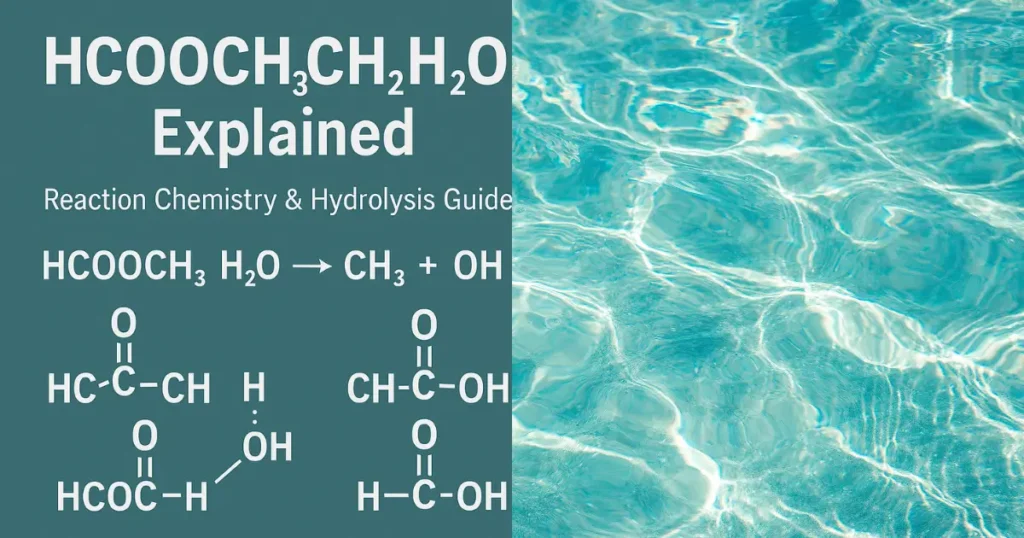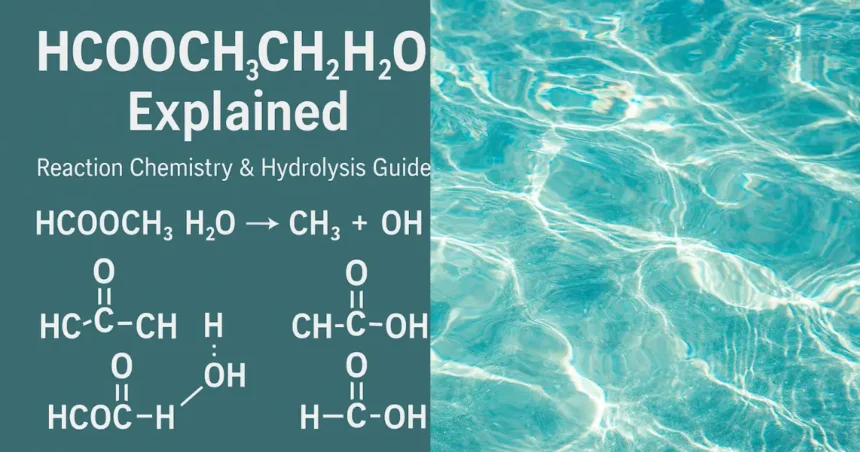
At first glance, HCOOCH CH2 H2O looks like a string of chemical abbreviations. But interpreting it properly requires organic chemistry knowledge.
This expression could represent a reaction pathway or an incomplete chemical notation referring to:
- HCOOCH₃: Methyl formate (an ester derived from formic acid)
- CH₂: Likely a methylene group or participating alkyl intermediate
- H₂O: Water, which could act as a nucleophile or solvent
TL;DR: HCOOCH CH2 H2O may imply a nucleophilic substitution, hydrolysis, or esterification reaction involving methyl formate, methylene, and water.
Chemical Breakdown of HCOOCH, CH2, and H2O
Let’s explore what each component in the string HCOOCH CH2 H2O chemically means.
1. HCOOCH – Possibly Methyl Formate or Similar Ester
HCOOCH₃ is shorthand for methyl formate, an organic ester formed by condensing formic acid (HCOOH) with methanol (CH₃OH).
Properties:
- Volatile liquid, fruity odor
- Common in perfume and flavor industries
- Reacts easily in acidic or basic hydrolysis
2. CH₂ – Methylene Group
A methylene (CH₂) group can appear:
- As part of a hydrocarbon chain
- As a reactive intermediate (e.g., in carbene chemistry)
- In organic linkages between esters and alcohols
In some reaction mechanisms, CH₂ connects or bridges functional groups.
3. H₂O – The Universal Solvent
Water (H₂O) plays multiple roles in organic chemistry:
- Hydrolyzing esters like HCOOCH₃ into their acid and alcohol components
- Making dilute solutions for heat-sensitive reactions
- Participates in acid-base catalysis or as a nucleophile
Is HCOOCH CH2 H2O a Real Chemical Reaction?
Although “HCOOCH CH2 H2O” isn’t written in textbook IUPAC notation, it likely refers to one of the following:
1. Hydrolysis of Methyl Formate
Methyl formate (HCOOCH₃) reacts with water (H₂O) in acid/base conditions to form:
HCOOH (formic acid) + CH₃OH (methanol)
Equation:
HCOOCH₃ + H₂O → HCOOH + CH₃OH
2. Intermediated Reactions With CH2-Based Compounds
If we consider CH₂ as a reactant (e.g. as a part of formaldehyde or alkenes), possible reactions include:
- Condensation reactions
- Aldol-type reactions
- Hydrated alkene intermediates
Hydrolysis Reactions Involving Formic Esters
Formic esters like methyl formate undergo acid-catalyzed hydrolysis, converting them back to formic acid and methanol.
Conditions:
- Catalyst: H₂SO₄ or NaOH
- Solvent: H₂O
- Heat: Mild (40–60°C)
Mechanism:
- Protonation of ester oxygen
- Nucleophilic attack by water
- Tetrahedral intermediate formation
- Elimination and alcohol formation
- Deprotonation
Applications in Organic Synthesis & Biochemistry
Esters like HCOOCH₃ (methyl formate) and related reactions with CH₂ and H₂O are used in:
- Flavor & fragrance development
- Creating biomass-derived fuels
- Drug precursor formulations
- Polymer intermediates
Real-World Use:
- Biodegradable solvents
- Flavor agents (ethyl formate, methyl formate)
- Intermediate in methanol economy research
Spectroscopic Identification & Molecular Analysis
To confirm the identity of HCOOCH-containing compounds:
1. NMR Spectroscopy
- 1H-NMR: Proton environments of CH₃, OH, CH₂
- 13C-NMR: Detects carbonyl carbon (C=O) at ~170–180 ppm
2. IR Spectroscopy
- ~1740 cm⁻¹ (Ester C=O stretch)
- Broad 3200–3400 cm⁻¹ (OH from water or acids)
3. Mass Spectrometry (MS)
- Look for m/z = 60 (methyl formate molecular weight)
- Fragment ions like m/z = 45 for formic acid or formaldehyde
Safety, Handling, and Reactivity
Handling Methyl Formate (If HCOOCH refers to it):
- Flammable, volatile
- Inhalation hazard at high concentrations
- Use in fume hood
- Store in cool, dry, well-ventilated space
Data Sheet Reference:
- PubChem Methyl Formate Overview
- NFPA Code: Flammability–3, Health–1, Reactivity–1
Frequently Asked Questions (FAQs)
Q1: Is HCOOCH CH2 H2O a real compound?
Not exactly. It appears to represent a shortened notation of a reaction mixture, likely involving methyl formate, a CH2-based molecule, and water.
Q2: What is the IUPAC name of HCOOCH?
Likely methyl methanoate, if fully formed:
HCOOCH₃ = Methyl formate
- Ester of formic acid (methanoic acid) and methanol
Q3: What happens when HCOOCH reacts with water?
A hydrolysis reaction occurs:
HCOOCH₃ + H₂O → HCOOH + CH₃OH
Q4: What is the role of CH₂ in this context?
CH₂ could be part of a methylene bridge or unstable reactive intermediate. In hydrocarbon chains, it often helps link functional groups.
Q5: Can this reaction be done in a laboratory?
Yes! Many beginners replicate esterification and hydrolysis in high school or college organic chemistry labs for practical understanding.
Conclusion & Takeaway
The expression HCOOCH CH2 H2O may look confusing, but it’s a peek into the versatile, reactive world of esters, water, and methylene groups in organic chemistry.
From perfume development to fuels and drug ingredients, understanding how esters and water interact is a foundational concept in chemical synthesis.








